With the San Francisco Flower Mart Tenants Association having opted to permanently relocate rather than return to a new and improved Flower Mart at 6th and Brannan, once the existing Flower Mart site is completely redeveloped, the refined plans for the new San Francisco Flower Market, between 16th and 17th Streets, at Mississippi in Lower Potrero Hill, are slated to be approved this afternoon.
While the existing modular office building on the corner of 16th and Mississippi would be razed to make way for a new, two-level parking structure with up to 180 off-street parking spaces, which could double as covered market space, the existing metal shed buildings on the 3.5-acre site, along with the historic brick office building fronting 17th Street, would be refurbished and reused, yielding 125,000 square feet of wholesale vendor space.
And yes, plans a 395-unit residential development designed to rise up to six stories in height upon the 901 16th Street site, with 25,000 square feet of ground floor retail and parking for 388 cars, had been approved back in 2016 but were subsequently derailed by neighbors.
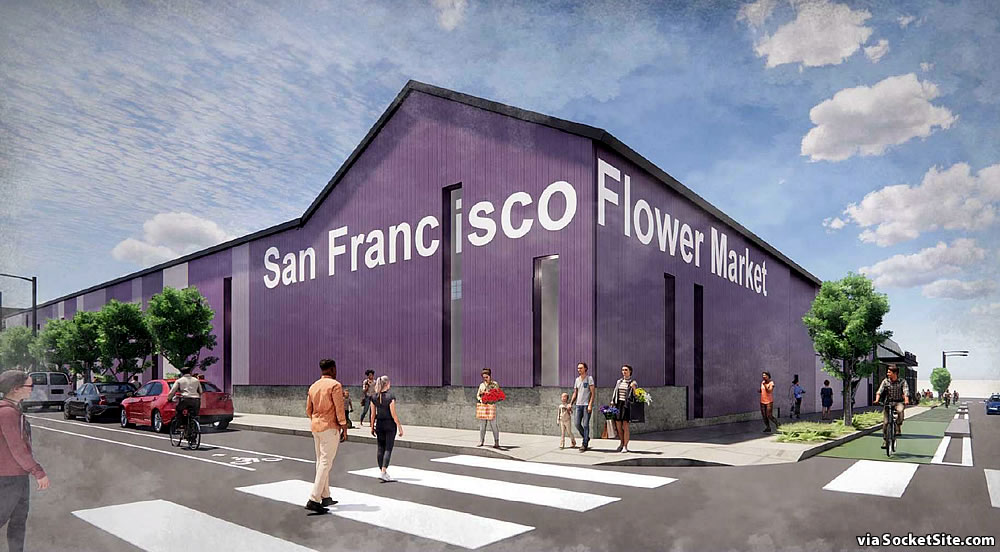
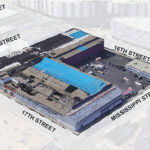
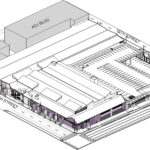
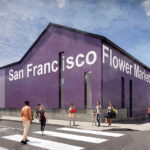
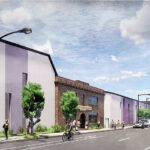
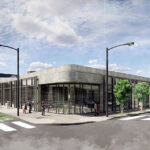
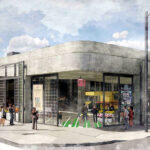
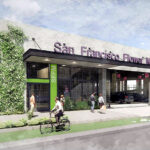
Not exactly excited to see that we’re getting a parking lot and warehouse space in place of housing and neighborhood-serving commercial activation—but also not surprised.
Don’t get me wrong, I’m happy to see Flower Mart is making things work, but It’s incredibly hypocritical for the neighbors (whichever group it was that led the charge against housing) would complain about traffic and noise and etc but be all about this land use.
[Editor’s Note: Another Battle Brewing Over Plans For Lower Potrero Hill Site (circa 2015)]
Buildings that provide jobs for people who don’t code for a living, bad; buildings that provide “neighborhood-serving commercial activation” (i.e., koder kid amenities: Starbucks, bubble tee, avo toasteries, ice cream museums…), good.
Still bizarre that you think everything is centered around young coders despite them making up a small percentage of the workforce. Maybe base your takes in reality and not some overstated stereotype… or not.
It’s the outsized negative influence that coders have on the city.
People love hating on techies because it avoids examining the inherent problem underlying the cognitive dissonance. Tech workers are just regular people, and gentrification could happen with any industry boom. All of these side effects are just a result of capitalism working as intended.
The inherent problem is creating jobs for people who don’t yet live here. City Hall jumps hoops to attract these tech companies, without a clue where the newly transplanted employees are going reside. Then they turn around and create bureaucracies like BMR housing to cover up their failure
San Francisco is not Detroit, where you have an existing population that needs jobs. We have too many jobs.
I’m amazed at how San Franciscans are ok with immigration of “certain” people but not others. And these same people consider themselves “tolerant.”
“We have too many jobs.”
That is a “problem” which virtually any other city in America would love to have.
Pretty interesting claim given that the coders basically pay for themselves and let the city run in place against a growing pension deficit. Without the coders, you get Oakland which is trying to steal streetlight repair funds to pave asphalt.
I certainly haven’t done the numbers myself but has anyone checked whether the city’s pension liabilities can survive without the steady boost from new development to house these new employees?
SF could easily be looking out for its existing population with those sweetheart deals, just not the ones being discussed here.
Re: pension liabilities, short answer is no, the city will not be able to cover its costs without continually growing its revenue through taxes.
The insinuation that new housing equates to ‘koder kid amenities’ is pretty tired rhetoric. Not every new business can be a dive bar, brewery, or venue my dude. And not every retail space ends up being the shortlist of clichés you’ve listed.
I’d wager more than a few people agree that this chunk of land would be much better as housing and that it’s somewhat ironic that the project opposition seems to prefer a warehouse and parking lot over giving people a place to live.
“[…] dive bar, brewery, or venue […] retail […].”
Ah, yes, the only jobs available for people with credentials in your SF are low-paid service industry jobs. PDR provides better paying jobs for people without university credentials. Not high-paying jobs, of course, and this will probably be impossible for people who make six figures can comprehend, but $20-$30/hr in skilled or semi-skilled PDR is considerably better than $15 in service (I’m not denigrating service as unskilled labor, only noting that its lower bar to entry gives it a lower wage structure).
Why does San Francisco still tolerate classism? Why does one have to have a credential in order to matter? Why are non-coders undeserving of work that pays better than jerking bubble tea for their hipster coder superiors?
As far “giving people a place to live,” that’s a canard. Giving people an affordable place to live is a completely different issue. Affordability is only exacerbated with every additional “market rate” unit added to a neighborhood, owing to the pressures of gentrification and speculation. There’s a glut of housing for coders, and a severe lack of housing for working class families.
“Why does San Francisco still tolerate classism?”
My dude, this is LITERALLY what you’re engaging in. Do you have absolutely zero sense of self awareness?
Also, you should probably stop lying about housing economics. It diminishes your already xenophobic, and pretty objectively wrong position.
“Affordability is only exacerbated with every additional “market rate” unit added to a neighborhood, owing to the pressures of gentrification and speculation. There’s a glut of housing for coders, and a severe lack of housing for working class families.”
Nope. It never ceases to amaze me how SF “progressives” can complain about conservatives being anti-science and then turn around and make statements like this. The science on this is clear. If you don’t believe me then I’ll happily suggest a reading list of NBER papers.
I can also provide a thought experiment. Let’s say we leveled SOMA and put up nothing but one hundred story residential towers with 20% mandated low income housing. Are you really arguing that this wouldn’t lead to lower housing prices for everyone? Or is there some infinite supply of evil coders hiding somewhere in the world just waiting for that extra piece of luxury housing to come onto the market just so that they can swoop in and drive up prices even further?
As a lifelong San Franciscan, the problem that I see isn’t so much with a fear of techies, it’s a profoundly conservative fear of change. People here over decades have said they don’t want the city to “become like New York.” Well fine. But all these problems you’re seeing is what you get in return. You can’t choose stasis. Change will come no matter what.
So many logical fallacies, so little time.
Acknowledging the existence of a unilateral top-down class war that has been waged by the top 1% and its 10% professional-managerial class lackeys against the working, middle, and impoverished classes for decades is not the same as waging class war.
I might make fun of the koder kidz, but I don’t hate them. My small sampling says individually they seem to be pleasant, if dull and predictable, for the most part. But they are an economic phenomenon that has played a huge role in determining rent and development in SF. They only exist because of tech sector vulture capitalists, who only exist because of historically accommodative Fed policy. Other factors in the RE bubble have been foreign capital flight, money launderers parking their money in over-priced SOMA condos, and AirBnB hosts (said hosts ironically, being economic parasites)..
The first day of Econ 1, one is informed of the magic wand of ceterus paribus, which explains that neo-classical theory only works in a vacuum. S&D tells a story that is much more complicated, ambiguous, and unquantifiable when externalities are considered. The reductio ad absurdum scenario of building a hundred towers would raise land acquisition costs so high that nothing in the city outside of the 20% affordable component would remain affordable. Not to mention that all the land that provided the best jobs for the presumable tenants of the 20% component would have been converted to towers, eliminating those jobs, obviating the need for that component. The thought experiment fails.
You inadvertently agree with my [albiet, failed] sarcastic remark about “not everything can be bars, breweries, and venues” and not everything ends up being “retail”.
The point, again, is NOT that flowers (or PDR) are bad. It’s that we’ve lost another well-deserved opportunity to build HOUSING and instead we get a longtime, well-established business that will likely bring very little if any new jobs to the area.
Housing. We need more housing. It’s excellent if it’s “BMR” but it still counts if it’s market rate.
I have never worked in tech (or desired to), but I do know tech people who never held a university credential — neither Apple or Google require applicants have a four-year degree, and most start-ups never did. Moreover, tech jobs have always been, and always will be, a small part of the overall jobs in SF.
Now, I do agree there is a shortage of affordable housing in SF; unfortunately, given how SF continued to restrict new development while at the same time tying the raising of funds for affordable housing to new development, I am certain there will always be a shortage of affordable housing in the city. SF will never be a place most working class or even middle-class individuals or families can afford, and though some members of these economic groups will remain in the city, they will always struggle to afford it.
Like Mariposa Exit isn’t bad enough already.
Mariposa and that exit both need one extra lane built into them.
This is not the old Center Hardware site. There is no on or off ramp for 280 adjacent to this.
There are literally on/off ramps touching the Center Hardware site on two sides (which is actually planning to become housing, fingers crossed) as well as one just east of 280 overpass.
The Center Hardware site is NOT the site of the new Flower Market proposal, and as such, any complaints about it being adjacent to the on/off ramps for 280 are wrong and irrelevant. Just read what you’re going to reflexively respond to before actually responding to it. It’s *really* easy. I promise.
I’m not sure mention of Mariposa meant that it was adjacent to the Flower Mart site. That’s your conclusion. I do, however, think it’s being implied that the Flower Mart project would increase traffic on the ramp as it’s less than a thousand feet away and likely to be used by delivery trucks and the like.
Just write a more effectively structured sentence and you could have cleared this up. Really easily even.
Just wait until 280 is torn down. Traffic problems will be solved.
Nice looking project. And in hindsight perhaps a good move? The Flower Mart initially wanted to be incorporated into the development at 6th and Brannan. It was later split off from the that project. Now groundbreaking has been pushed back to late 2021 – it had been set for early 2020. But, given the plethora of office space available and soon to be available in SF, who knows how long before ground is broken. The Flower Mart could have been in limbo if it had remained a part of the actual project. Possibly forced to leave the city (not sure how viable its current temporary site is long term) and take with it previous non-tech jobs.
The mantra of housing housing housing has its own problems. Is it really good planning from a long term large scale perspective to cram more people into a seismically active, drought-prone, climate change sensitive state like California? Maybe decentralizing the population a little more is not a bad thing? Eternal population growth, eternal economic growth is not all that sustainable. Of course, we have our Cascadian Cassandra here, who was earlier suggesting everyone move to the exurbs. Which are now catching on fire, of course.
Anthropomorphically, capitalism doesn’t care about resiliency and sustainability (let alone remotely equitable distribution of gains to productivity). Maximal population growth by any means – here! now! – is the clarion call of capitalism’s gleeful rush to the cliffs. More within this site’s focus, without population growth, the extractive, parasitical FIRE sector of the economy is DOA.
It’s well documented that as countries get richer (mostly through the adoption of capitalism), population growth goes down as the cost of raising children (college) exceed the benefit (free labor on the farm). You are certainly right that sustainability is generally not internalized in capitalistic systems without regulation. But, stating that capitalism pushes for population growth is simply incorrect. Heck, at our current state, a significant concern is that capitalism will lead the mass layoffs due to the adoption of automation.
“countries get richer” is a deceptive concept if you’re only referring to aggregate GDP, and not how the gains are distributed throughout an economy.
Slower population growth occurs when the standard of living is improved for the working class. i.e. countries with lower Gini coefficients. A country might have rapid aggregate GDP growth, but if the gains to productivity aren’t spread out, then population growth does not slow. This phenomenon occurs in any type of economy, not just capitalism..
A wealthy economy in which the wealth is highly concentrated (like ours) is not a healthy economy.
Are you kidding? It’s exceptionally more sustainable and effective for populations to be centralized. Spreading the population out (for the most part) is the single most detrimental thing we’re doing to the environment and isn’t exactly unrelated to unnecessary economic stress.
Not everything is an extreme. Promoting density and more housing doesn’t mean that it’s “eternal population growth”. Unless you’re suggesting we all stop reproducing?
Huge disagree, as the spread of residential development to exurbs such as the rolling grasslands of Vacaville or wooed hillsides such as the foothills, Sonoma and Napa, is one reason for vastly increased fire risk.
I’m talking about overall population growth. And I actually agree that low density sprawl (a la the Cascadian Cassandra) is a bad idea. My concept of decentralization, though, is focused on the larger issues. I think as a nation, the move to the SUNBELT may prove to be an error. How will Phoenix look when temperatures regularly reach 120 in summer…for days at a time. My thoughts, not clearly expressed, is that we should not bemoan the “people moving to Tennessee” meme. There are cities in the east and Midwest….with plentiful water, great architectural heritage, etc. where more people should probably move to. Although who likes winter?
As the lovely exurban dream erupts in flame yet again, I did not mean to say that everyone should move to Vacaville or the Sierra foothills. Thjey should probably move to Kansas or Indiana or Pennsylvania. 🙂 Not that there is any means to force this reevaluation of understandable population preferences. Heck, I hate winter. I left winter 30+ years ago. But as a matter of public policy: more more more is not sustainable either.
why not have the flower mart on the first floor and 3-5 floors of housing?
Really, this is the only valid critical question posed here. Is there some regulation prohibiting housing above this type of use (i.e. is it considered industrial or something like that?). Seems like you could have 2 levels, or a single tall level, at the bottom for the Flower Market and a few floors of housing above. Then you’d have *gasp* both jobs and housing.
Agreed, this would be a great ground floor use with housing above. 16th street is too important as an arterial for low/ no density. Only issue is the 5 year lead time to approve such a development
Housing should be separate from PDR. PDR operational conditions (noise, smells, hours) and good housing conditions don’t mix well. Over time, residential complaints constrain business operations. The answer, of course, is to tear down all buildings that provide jobs for working class people, and turn them unto “creative” office spaces with “fun” furniture and scooter docks below two-burnered, frat-fridged, micro living cubes with rooftop hot-tubs for nascent grads of America’s finest institutions of higher video game programming.
two beers, when I win the lottery I am going to contact you somehow and FUND YOUR VISION, MAN! ESPECIALLY THE ROOFTOP HOT TUBS.
Lime green walls with hot pink trim, 24 hr bubble tea, virtual reality ping pong, and group flash mob staging, or the deal’s off, man.
Oh, and electric dishwashers. Dishwashers for micro units with kitchenettes featuring two electric burners and an undercounter frat fridge. Considering the few meals eaten at home in the coder cubicles are delivered and eaten out of waxed paper boxes, those dishwashers really come in handy.
Who exactly are you building this housing for?
Are you not aware of the complete and utter exodus out of this city over the past 5 months?
The HOUSING SHORTAGE IS SOLVED. Everyone is ABANDONING San Francisco area. EVERYONE.
Phoenix is lovely in the summer, I hear. And Houston…at least the three hurricanes per year bring plenty of water! And Nashville is nice, too. I want to live next to 300 pound “rebels” in Confederate reenactment gear!
Yea, put housing above and stand back for the throngs of people dying to move in upstairs from a place that is filled with 18-wheelers starting at 3:30 AM, followed by hundreds of vans and smaller trucks until noonish, followed by the stench of rotting plant material and rats. Should be lovely.
I expect that purple paint isn’t going to hold up well with graffiti. They could fill the whole wall with a mural of 100’s of flowers?
That and a Yayoi Kusama flower sculpture like the one at 33 Tehama! Can’t think of a better place for one.